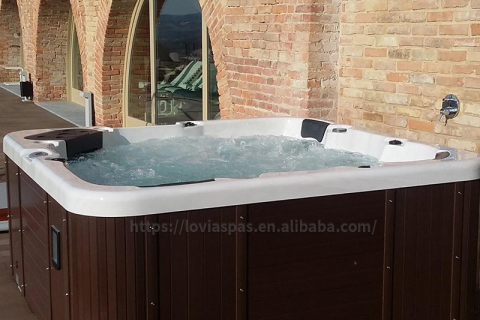
- Home
- >
News
Advantages of long-term opening ● Maintaining massage effect: Turning on the relaxation nozzle for a long time can maintain continuous water flow massage, help relieve muscle tension, and bring a deeper relaxation effect. ● Good water circulation effect: The long-term opening of the nozzle helps the water body circulate, which can prevent the water quality from becoming turbid, and at the same time allow the disinfectant to be fully distributed in the water.
When the pH level in a hot tub is too low, the water becomes acidic, which can have significant effects on the skin. Acidic water weakens the natural barrier on the surface of the skin, making the skin more vulnerable to chemicals and bacteria, which can cause problems such as rashes.
Studies have shown that soaking in a hot tub for an hour may burn the same calories as taking a walk or doing a low-intensity exercise. This means that while hot tubs are not a replacement for exercise, they can certainly be used as an aid to weight loss, especially for those who are physically unable to engage in vigorous exercise, as hot tubs offer a low-impact, stress-free way to burn calories.
For example, an adult over 1.75 meters tall may need a soaking depth of 45 cm or more to ensure that the shoulders are covered by water. For people under 1.60 meters tall, a soaking depth of about 40 centimeters is comfortable enough.
Advantages of bromine: Stable under high temperature conditions Less irritating Continuous sterilization ability Bromine has certain disinfection ability Not susceptible to pH fluctuations Disadvantages of Bromine: Higher cost Not as oxidizing as chlorine Bromine accumulation problem Requires regular maintenance and replenishment Compatibility with devices
In theory, a forklift can indeed lift a hot tub. After all, forklifts are originally designed to move heavy and bulky objects. Most hot tubs weigh between 300 and 900 kilograms, depending on their size, materials and design, and the maximum weight capacity of a forklift is usually in excess of this range, so from a load-bearing capacity perspective, a forklift is capable of handling this type of task.
Weak water flow or no water flow from the nozzle is one of the most direct manifestations of air lock. Air locks prevent the pump from building up enough water pressure, causing the water flow rate of the nozzle to be significantly reduced, or even completely unable to discharge water.
many people may have such questions when purchasing or using hot tubs: "Are all massage hot tub jets the same?" The answer is that not all massage hot tub jets are the same. In fact, different types of jets have different designs and functions, each suitable for different massage needs.
A two-person hot tub with a capacity of 300 liters may take less time to heat up than a 500-liter bathtub. Taking a 3kW heater as an example, it may take about 1.5 hours to heat 300 liters of water from cold water to 40 degrees Celsius, while a 500-liter bathtub may take closer to 2 hours or more.
Chlorine is a very common disinfectant and is widely used in the water quality maintenance of swimming pools and hot tubs. Chlorine kills bacteria, viruses and other harmful microorganisms in water by releasing hypochlorous acid. The strong oxidizing property of hypochlorous acid can effectively destroy the cell wall of bacteria and the protein structure in the cell, thereby quickly killing bacteria.
There may be many reasons why a hot tub cannot heat up, such as: 1. Heater failure 2. Power problem 3. Thermostat failure 4. Pump failure 5. Filter blockage 6. Low water level 7. Heater overheat protection mechanism activated 8. Inadequate energy supply
When choosing a hot tub, the first thing to do is to read and understand its specs in detail. Each hot tub has different technical specifications that directly affect its performance, user experience, and maintenance costs.












